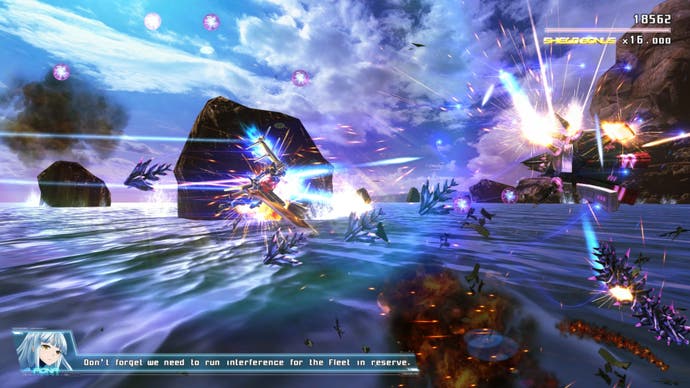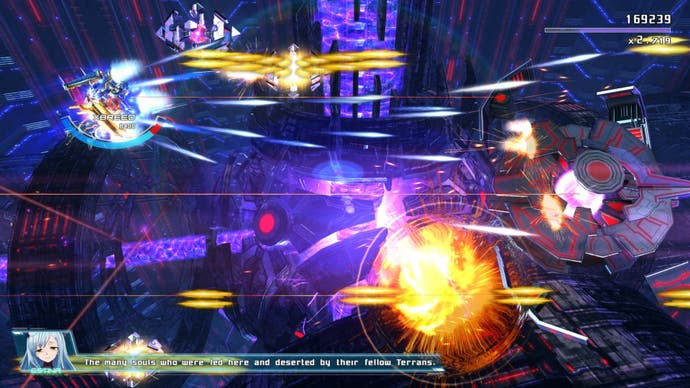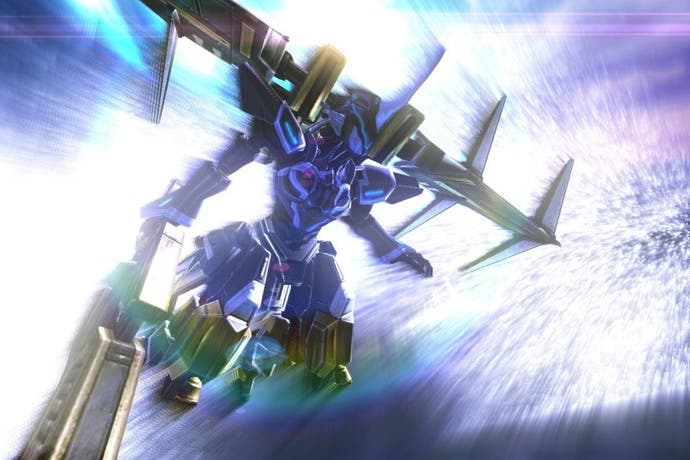Astebreed review
Bullet belle.
Fashion is cyclical, circling in dependable 20-year loops that enable clothes-makers to sell styles back to us that, not so long ago, they insisted were outmoded. This freshening cycle may yet be replicated in video games: NES-era pixel-art has enjoyed a long and profitable revival, particularly within indie games, where the aesthetic has provided other, technical advantages to the semi-professional game-maker. Astebreed, a lavish indie game from the Japanese studio Edelweiss, is one of the first to suggest a new dawn in indie-game fashion: a return to the coarse polygons of the 32-bit era, when Sega's Saturn and Sony's PlayStation boldly explored the potential of 3D art.
This shoot-'em-up rejects the frantic bullet-dodging ballet of Cave's niche-dominating output and instead draws inspiration from Squaresoft's Einhander and Treasure's Radiant Silvergun: games defined by dramatically tilting camera angles, a cinematic journey through distinct levels and intricate scoring systems. Astebreed bears all of these hallmarks. Its six stages offer a cacophony of visual noise and spectacle tempered by a scoring system that encourages thoughtful, considered play.

In presentational terms, the game draws more heavily from the anime tradition than its video game inspirations: you pilot a flying mecha, known as an Xbreed, equipped with a bullet-eating plasma sword and orbited by a cluster of bullet-firing lights, known as Lucis. The game's stages build in scale and drama like the most ostentatious space anime. You begin flying over a sunlit coastline, shooting down swarms of flitting foes while the camera wheels and twists in exciting ways. By the end of the game, the action has escalated absurdly: you're in the galaxy attempting to slice hulking spacecraft in two with your quivering sword.
The involved storyline is told during play in a manic babble of Japanese voices. It's impossible to read the ticker-tape subtitles while simultaneously managing the battlefield, so unless you're a fluent Japanese speaker, your understanding of the game will be limited to the reams of background text, unlocked when you finally best the final boss.
The language of the game's scoring system is, however, well explained through a series of tutorials. These are optional but nevertheless essential if you're to understand how best to approach the game. Your Xbreed's attacks are divided into two types: ranged and melee. The ranged, shot attacks come in two varieties: scatter (whereby the bullets spread out in an expanding cone) and focus (where they cluster in a thick column of fire). It's also possible to trigger a homing attack with either shot type by holding down the attack button to create a lock-on zone around the ship. The longer you hold down the attack button, the more of your Lucis will shoot forward to destroy the targets when you let go - although this will leave you momentarily unable to shoot until the Lucis return to your side.

Your melee attack is more powerful but only effective at short range. This can also be used to dart towards enemies with a lunging attack, useful for moving your position in an instant and an effective tactic when cornered by a boss' snookering attacks. Finally, every time one of your attacks hits a target, a special move gauge fills up (usefully, this is displayed in a micro-HUD, millimetres below your ship itself). Once it's filled, you can trigger your most powerful 'EX attack', which comes in three varieties depending on whether you are locked on to a single enemy, multiple enemies or none at all. The EX gauge fills up quickly so, in the midst of the action, you're able to trigger special moves every few seconds.
One of Astebreed's most interesting inventions is the use of colour-coded enemy bullets. Lucis attacks will destroy yellow bullets. Both yellow and purple bullets dissipate when sliced with your sword. Red attacks, however, are impervious to all your defences. The temptation, then, is to simultaneously shoot your Lucis bullets while thwacking your sword (both attacks can be triggered at the same time) in order to nullify two thirds of the incoming bullets, leaving you to merely dodge the red projectiles.
This approach makes the game somewhat easier, but Edelweiss discourages this play-style with its scoring system. As you destroy enemies and their shots with your Lucis, you trigger a score multiplier (up to 16x). Blade attacks, however, will decrease the multiplier. Players hoping to achieve high scores will want to destroy weaker enemies with Lucis bullets and then 'bank' the multiplier by destroying a high-value foe with a blade or EX attack. It sounds more complicated than it is, and once you've grasped the system, Astebreed's tactical heart comes to the fore. It's worth taking the time to master it: without this understanding, Astebreed is a good-looking but broadly uninteresting shoot 'em up.

Score attack is essential to Astebreed's mid- to long-term appeal as this is, final boss aside, not a particularly challenging game. Your Xbreed's health bar is generous and will replenish after a few seconds when you cease to take damage. Neither will you lose health when banging into enemy ships (unless, that is, they have a red glow around their hull), so it's possible to hack and slash your way through swarms of enemies without taking any damage. Played this way, the game is stylish but empty.
But with its delicious score system taken into account, Astebreed is well-constructed, well-presented and well-balanced. A certain amount of delight comes from the novelty of a 32-bit-esque indie game, as it offers a welcome change from the army of sprite-based titles of the previous few years. Viewed on its underlying merit, this is a weaker game than its years-old inspirations - both Radiant Silvergun and Einhander best it in terms of interesting systems and set-pieces - but Astebreed is, nevertheless, a strong and idiosyncratic proposition.

